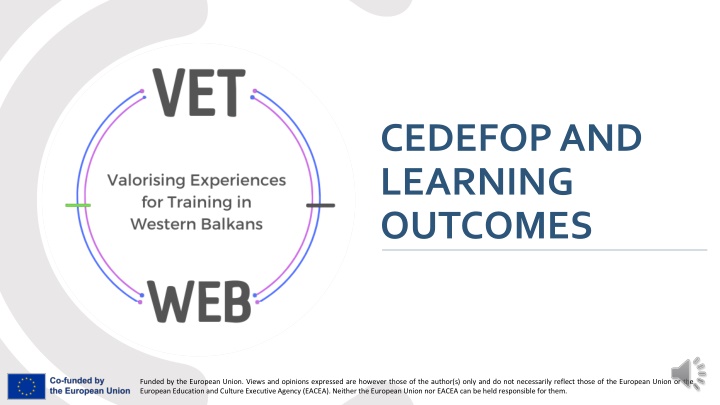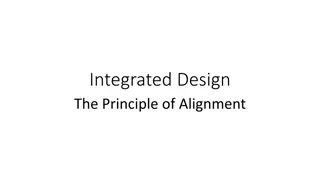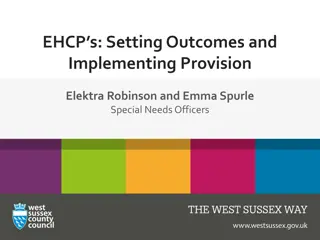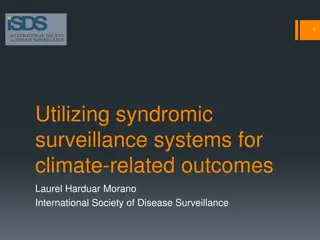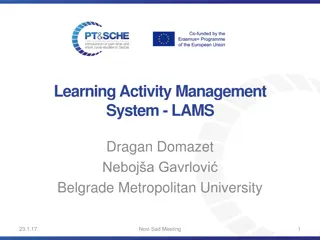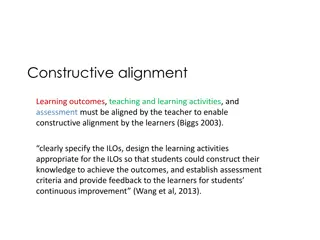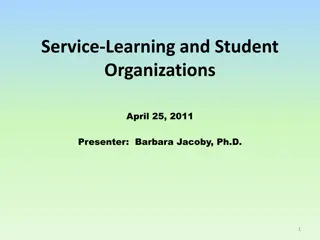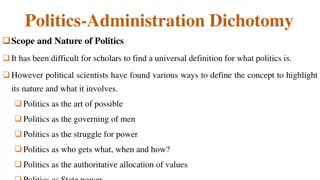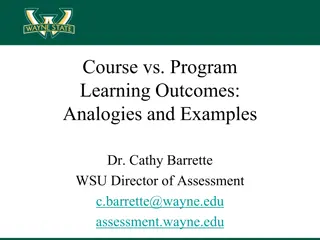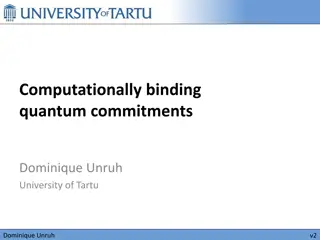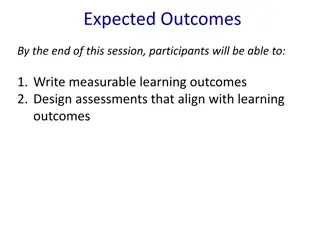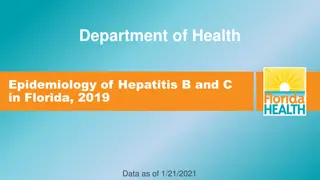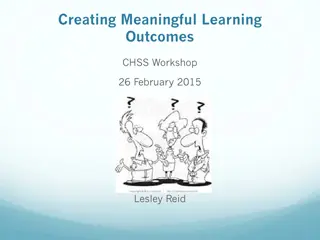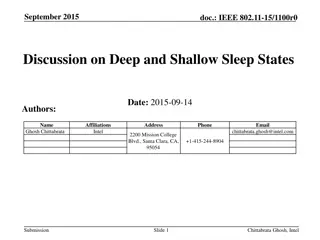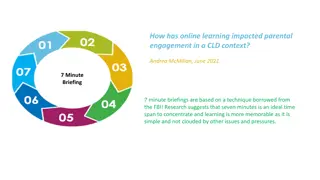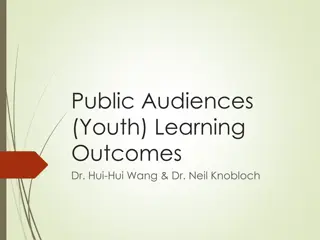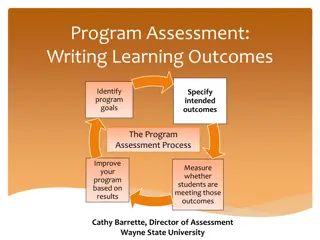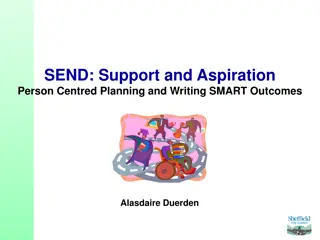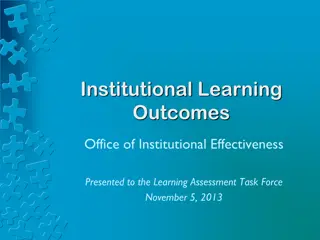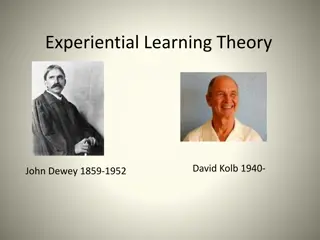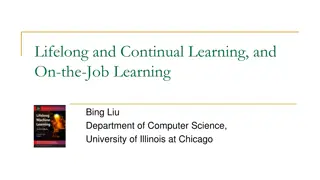CEDEFOP and Learning Outcomes: Understanding Definitions and Applications
CEDEFOP, funded by the European Union, is a key agency in the development of education and training. This article explores the concept of learning outcomes, their definitions, and the importance of their application in various educational settings. Through events, studies, and resources, CEDEFOP aims to promote lifelong learning and facilitate progression and mobility. Discover the significance of learning outcomes and how they contribute to enhancing education across Europe.
Download Presentation

Please find below an Image/Link to download the presentation.
The content on the website is provided AS IS for your information and personal use only. It may not be sold, licensed, or shared on other websites without obtaining consent from the author.If you encounter any issues during the download, it is possible that the publisher has removed the file from their server.
You are allowed to download the files provided on this website for personal or commercial use, subject to the condition that they are used lawfully. All files are the property of their respective owners.
The content on the website is provided AS IS for your information and personal use only. It may not be sold, licensed, or shared on other websites without obtaining consent from the author.
E N D
Presentation Transcript
CEDEFOP AND LEARNING OUTCOMES Funded by the European Union. Views and opinions expressed are however those of the author(s) only and do not necessarily reflect those of the European Union or the EuropeanEducation and Culture Executive Agency (EACEA).Neither the EuropeanUnion nor EACEA can be held responsible for them.
INDEX UNIT 1 Introduction and definitions UNIT 2 Learning outcomes users UNIT 3 Defining the Learning outcomes 2
Unit 1_Introduction and definitions CEDEFOP CEDEFOP is the EU agency for the development of education and training. The agency s official website provides for several strategic resources for VET providers across Europe. These kind of resources goes from publication and reports, to operative online tools available for the use of professionals from the most vary themes. Most importantly, in cooperation with the European Commission, CEDEFOP proactively operates to give concrete application to EU Parliament & Council s 2009 ECVET recommendation a common EU instrument to help individuals in transfer and accumulate their learning outcomes across EU. 3
Unit 1_Introduction and definitions CEDEFOP AND LEARNING OUTCOMES Cedefop is regularly organising events on the topic of learning outcomes, allowing policy makers and practitioners to compare practises and exchange experiences. Cedefop has carried out a number of studies mapping and analysing the use of learning outcomes for different purposes. These studies support policy developments at EU, national and sectoral level and analyse how an improved use of learning outcomes can promote lifelong learning and reduce barriers to progression and mobility. 4
Unit 1_Introduction and definitions LEARNING OUTCOMES DEFINITIONS There are two main, interrelated definitions of this concept: (a) learning outcomes are knowledge, know-how, information, values, attitudes, skills and/or competences a person has acquired and/or is able to demonstrate after completion of a learning process, either formal, non-formal or informal (Cedefop, forthcoming); (b) learning outcomes are statements regarding what a learner knows, understands and is able to do on completion of a learning process, which are defined in terms of knowledge, skills and responsibility and autonomy (Council of the European Union, 2017). 5
Unit 1_Introduction and definitions INTENDED AND ACHIEVED LEARNING OUTCOMES This relationship can be expressed as a loop where the interaction between what is intended and what has actually been achieved feeds into a continuous improvement process. Relationship between intended and achieved Learning Outcomes Achieved Learning Outcomes Intended Learning Outcomes 6
Unit 1_Introduction and definitions INTENDED AND ACHIEVED LEARNING OUTCOMES Achieved learning outcomes can only be identified following the learning process, through assessments and demonstration of achieved learning in real life, for example at work. Consistent application of learning outcomes requires continuous dialogue between intended and actual outcomes, seeking to improve stated expectations (intended learning outcomes) based on actually achieved outcomes. Dialogue between the world of education and work, and society at large, is crucial to successful implementation and continuous review and renewal of the learning outcomes approach (Cedefop, 2021). 7
Unit 1_Introduction and definitions LEARNING OUTCOMES COMPETENCES The focus on actually achieved learning outcomes brings in competence, defined by Cedefop as the ability to apply adequately in a defined context (education, training, work development) . Competence can be understood as actually achieved learning outcomes, through the ability autonomously to apply knowledge and skills in practice, in society and at work. the concept of validated learner of the learning outcomes or professional 8
Unit 2_Learning outcomes users MAIN USERS OF LEARNING OUTCOMES Learning outcomes are used for a wide range of purposes and by a wide variety of users. Consequently, and directly reflecting different needs, they must be defined and described in format, length and detail in ways which suits these users and their needs. 9
Unit 2_Learning outcomes users MAIN USERS OF LEARNING OUTCOMES THE LEARNERS Learning outcomes statements clarify what a learner is expected to know and be able to do and understand, having completed a learning sequence, a module, a programme or a qualification. They can: support the initial choice of education and training; help to orient the learning process itself; clarify what to expect during assessment or validation. However, for learning outcomes statements to make any difference to learners, they must become visible and be used as a reference point at all stages of the education and learning process, from the initial choice of programme to the final assessment. 1 0
Unit 2_Learning outcomes users MAIN USERS OF LEARNING OUTCOMES THE TEACHER AND INSTRUCTOR For the teacher and/or instructor, the learning outcomes approach helps to: orient teaching; select methods ; support the individual learner throughout the learning process. From a teacher s point of view, the design of learning outcomes can pursue two very different objectives: statements can be defined and described in a high level of detail, giving as clear as possible orientation to the teacher; statements can alternatively be kept at a more general level, leaving room for individual and contextual adaptation. 1 1
Unit 2_Learning outcomes users MAIN USERS OF LEARNING OUTCOMES THE ASSESSOR For the assessor, the learning outcomes should clarify: the criteria for success/failure and performance; the area of learning being assessed, indicating what is relevant and not. The role of learning outcomes for assessment is well illustrated by the gradual introduction of validation of non-formal and informal (prior) learning in European countries. The shift to learning outcomes has been essential for these developments, making it possible to assess (make visible and value) learning outside classrooms, at work and in leisure time. Introducing learning outcomes-based qualification standards allows the assessor to use the same reference points for different purposes and end-users. 1 2
Unit 2_Learning outcomes users MAIN USERS OF LEARNING OUTCOMES THE EDUCATION AND TRAINING PROVIDER For the education and training institution, learning outcomes: provide an important instrument for developing as well as reviewing programmes and qualifications; provide the basis for systematic dialogue with labour market and society stakeholders regarding evolving skills needs; help to determine the purpose and orientation of a course, a programme or qualification and to clarify how it relates to and/or overlaps with other courses/programmes and qualifications; provide an important reference point for quality assurance and close dialogue with end-users. 1 3
Unit 2_Learning outcomes users MAIN USERS OF LEARNING OUTCOMES LABOUR MARKET AND SOCIETY For society and the labour market, learning outcomes provide a common language allowing different stakeholders in education and training, as well as the labour market and society at large, to clarify skills needs and to respond to these in a relevant way. The definition of learning outcomes requires systematic reflection on the use of labour market intelligence and how this will be balanced with the ability of the education and training system, and of teachers, to support education, training and learning. 1 4
Unit 3_Defining the Learning outcomes DEFINING AND WRITING LEARNING OUTCOMES THE FUNDAMENTALS (1) learner is always put at the centre; When writing learning outcomes, the outcomes are distinguished. The former are statements of intentions and expectations, the latter can only be identified following the learning process, through assessment and demonstration; Intentional and achieved learning Using learning outcomes represents a perspective and a mode of thinking. The focus is always on the learner and what he/she is expected to know, be able to do and understand. 1 5
Unit 3_Defining the Learning outcomes DEFINING AND WRITING LEARNING OUTCOMES THE FUNDAMENTALS (2) continuous dialogue (the feedback loop) between intended and actual outcomes; Improving the way learning outcomes are defined, described and used requires as well as unintended, desirable as well as undesirable outcomes; Learning outcomes must remain open to the explorative and to what has yet to be experienced and articulated; Learning outcomes never operate in isolation but must be defined and written within a broader context where learning inputs are considered; The learning process can rarely be fully predicted and described; it has intended 1 6
Unit 3_Defining the Learning outcomes DEFINING AND WRITING LEARNING OUTCOMES THE FUNDAMENTALS (3) elsewhere. Learning outcome statements should be authentic and reflect the context being addressed; It is important to avoid copying (cut and paste) learning outcomes from a national qualifications framework differ significantly in detail and specificity from those used in a national curriculum, a qualification standard, a programme description, or an assessment standard. Learning outcomes must be fit for purpose and the level of detail/granularity and generality/specificity must reflect this; While written for different purposes and varying in detail, learning-outcomes- based frameworks, qualifications standards and profiles, curricula and assessment criteria should be related and mutually inform each other; Learning outcomes will be written in ways which reflect different interests; Learning outcomes are written for different purposes. The descriptors used for 1 7
Unit 3_Defining the Learning outcomes DEFINING AND WRITING LEARNING OUTCOMES THE FUNDAMENTALS (4) competences needs to be decided in a dialogue between relevant stakeholders, reflecting the purpose of the intervention; The balancing of general subjects, occupational skills and transversal individual and local adaptation and interpretation. Learning outcomes should support alternative learning pathways and choices. Learning outcomes do not aim fully to predict and control the learning process; National qualifications frameworks, defining levels of learning outcomes, can be used as reference points, aiding consistent interpretation and application of learning outcomes (calibration); Teaching specifications can be supplemented by outcome information. Learning outcomes need to be defined and written in a way which allows for 1 8
Unit 3_Defining the Learning outcomes DEFINING AND WRITING LEARNING OUTCOMES (1) outcomes should be treated as an iterative process, starting from overall objectives and moving stepwise towards specific statements for units and assessment; Defining and writing learning Simplicity is important when writing learning outcomes. orient qualification statements considered (limit the number of statements); When writing learning outcomes to a qualification/programme unit/course, used should or a the number be of carefully 1 9
Unit 3_Defining the Learning outcomes DEFINING AND WRITING LEARNING OUTCOMES (2) statement, it is recommended to focus on the learner and start with an action verb, followed by the object of the verb as well as a statement specifying the depth/breadth of learning to be demonstrated, and complete with an indication of the context; When writing a learning outcomes statements makes it easier for the learner to relate to the intentions and engage in the learning. It also makes it easier to plan teaching, to facilitate learning and to carry out assessments; Limiting the number of more than one action verb for each learning outcome. In general, there should not be 2 0
Unit 3_Defining the Learning outcomes THE BASIC STRUCTURE OF LEARNING OUTCOMES STATEMENTS The basic structure of learning outcomes statements should: Address the learner Use an action verb to signal the level of learning expected. Indicate the object and scope (the breadth) of the expected learning. Clarify and/ or social context in which the qualification is relevant. the occupational depth and Examples is expected to present in writing the results of the risk analysis allowing others to follow the process replicate the results. The student is expected to distinguish the effects environmental of cooling gases used in refrigeration systems. The learner between 2 1
Unit 3_Defining the Learning outcomes THE VERTICAL DIMENSION OF LEARNING OUTCOMES STATEMENTS of learning outcomes statements is about indicating the level and complexity of learning. This will normally require referring to a hierarchy (implicit or explicit) of intended learning achievements. The EQF exemplifies such a hierarchy, illustrated by the columns in the next Table. Introducing the vertical dimension Learning outcomes statements need to capture the depth and complexity of learning. Addressing the depth of learning requires agreeing on the criteria for levelling and complexity. outcomes and 2 2
Unit 3_Defining the Learning outcomes EXEMPLIFYING THE VERTICAL DIMENSION OF LEARNING OUTCOMES: THE INCREASING COMPLEXITY OF AUTONOMY AND RESPONSIBILITY (EQF DESCRIPTORS) The learner The action The object The context EQF Learner is expected to take completion of tasks in work or study adapting behaviour circumstances solving problems within the guidelines of work contexts usually predictable, but are subject to change own responsibility for to in level 3 EQF Learner is expected to exercise self- routine work of others management or that study are level 4 to supervise work or study responsibility take some activities improve evaluate and EQF Learner is expected to exercise performance of self and others in contexts of work or study activities where there unpredictable change management, supervise, review level 5 is develop 2 3
Unit 3_Defining the Learning outcomes ALIGNING LEARNING OUTCOMES TO TEACHING AND LEARNING (1) The application of learning outcomes is a question of aligning learning outcomes statements with teaching and learning. The statements should assist teachers in identifying and combining teaching methods. Teachers should be involved in the definition and writing of learning outcomes to advise on the level of prescription/openness. Extensive collaboration among teachers from different fields can make positive contributions to flexible learning pathways. The key is that all components in the teaching and learning system are aligned to each other and support achieving the intended learning outcomes. 2 4
Unit 3_Defining the Learning outcomes ALIGNING LEARNING OUTCOMES TO TEACHING AND LEARNING (2) Aligning learning outcomes to teaching and learning is about connecting the abstract idea of a learning outcome to what teachers actually do to help students learn, and the things that students do to learn. The outcomes approach requires teachers to pose and answer the questions: what do I intend students to learn (what learning outcomes do I want them to achieve)? what teaching methods and curriculum design can be used to encourage students to behave in ways that are likely to achieve these outcomes? what assessment tasks and criteria will tell me that students have achieved the outcomes I intend? how can formative and summative assessment be combined to support the learning process and to clarify whether outcomes have been achieved? 2 5
Unit 3_Defining the Learning outcomes ALIGNING LEARNING OUTCOMES TO TEACHING AND LEARNING (3) Implementing learning outcomes depends on a clear link being established between the learning outcomes statements and the learning and teaching process. This requires that learning outcomes statements for different purposes (qualifications standards, programme profiles and curricula) be related to each other and do not operate as isolated and separated elements. 2 6
SUMMING UP (1) national, institutional and/or discipline context. They need to be fit for-purpose and there is no single fit-for-all solution; Learning outcomes are always written for particular purposes and applied in a flexibility. Learning outcomes need to be formulated in a way that supports or allows for flexibility in approaches to learning and qualification; If learning outcomes are too broad and generic, they will need to be complemented by more detailed school curricula or assessment standards; The use of learning outcomes needs to strike a balance between rigidity and 2 7
SUMMING UP (2) If learning outcomes are too specific, it can be difficult for people coming from outside the formal education and training system to fully understand them; If qualifications descriptions are too specific (especially if they have a binding aspect) they may hinder evolution and innovation as they would need to be updated too often; The use of learning outcomes can bring a strong focus to the purposes of teaching, assessment, validation and certification. Learning outcomes provide the language that enables different (quality assurance) stakeholders to interact and coordinate. 2 8
SELF-EVALUATION TEST CEDEFOP is the EU Agency for the development of education and training. True False Learning outcomes can be defined as a continuous dialogue between: When writing a Learning outcome, it is important to be: Assessed Learninig outcomes and Achieved Learninig outcomes Intended Learning oucomes and Achieved Learning outcomes Intended Learninig Outcomes and Adjusted Learninig Outcomes Very informative and detailed, preferring long sentences Simple and concise, limiting the number of sentences None of the above mentioned options 2 9
SELF-EVALUATION TEST SOLUTIONS CEDEFOP is the EU Agency for the development of education and training. True False Learning outcomes can be defined as a continuous dialogue between: When writing a Learning outcome, it is important to be: Assessed Learninig outcomes and Achieved Learninig outcomes Intended Learning oucomes and Achieved Learning outcomes Intended Learninig Outcomes and Adjusted Learninig Outcomes Very informative and detailed, preferring long sentences Simple and concise, limiting the number of sentences None of the above mentioned options 3 0
THANK YOU MARIANNA.MUIN@IAL.FVG.IT HTTP://WWW.IALWEB.IT/ Funded by the European Union. Views and opinions expressed are however those of the author(s) only and do not necessarily reflect those of the European Union or the EuropeanEducation and Culture Executive Agency (EACEA).Neither the EuropeanUnion nor EACEA can be held responsible for them.
